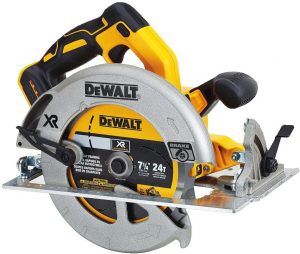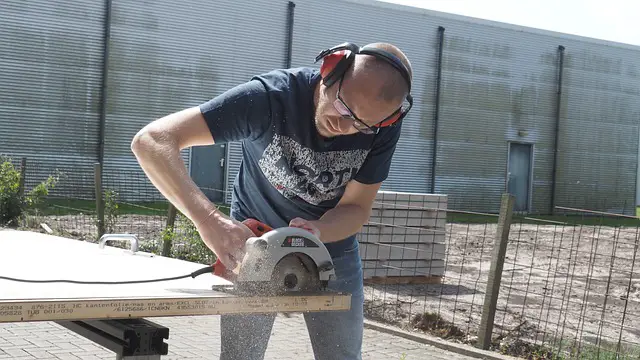Welcome to my article about jigsaws vs circular saws. These are two different yet common types of power saws, both with a vast array of applications for both DIYers and tradies.
I decided to compare these two saws because, despite their many differences, many people get stuck choosing between them.
Below I will go through what a jigsaw and a circular saw are, their most common uses, pros and cons, and the differences and similarities between the two.
But first, a quick summary and comparison table!
Contents
Jigsaw vs Circular Saw – A Summary
Don’t have time to read through the entire article? No problem! Here is a quick summary of the differences between a jigsaw and a circular saw:
A jigsaw is a small hand-held power saw that has a thin blade which moves in an up and down motion. It’s best for people who work on light-duty projects where small, curved or intricate cuts are required. A circular saw has a rotating disc that is ideal for cutting large amounts of wood or other materials in a straight line. It’s a more heavy-duty machine and is better suited to the high-volume work that tradies or regular hobbyists would do.
Jigsaw and Circular Saw Comparison Table
Here is a side by side comparison table so that you can easily compare the differences and similarities between a jigsaw and a circular saw.
 |  | |
Ok, now let’s get into the detailed information about jigsaws and circular saws
Jigsaws
What is a Jigsaw?

Also called a saber saw, a jigsaw is a small and lightweight power saw that features a small blade which rapidly moves up and down (similar to the motion of a needle in a sewing machine).
It is handheld in a vertical position and is suitable for intricate and detailed woodworking jobs and cutting curves, angles and patterns.
Uses for a Jigsaw
Jigsaws are ideal for cutting complex shapes and curves in wood, metal, ceramic tiles, carpets, and even concrete.
You can use them to craft short crosscuts on a board and finishing inside corners. You can create plunges, bevels, and standard straight cuts.
Jigsaws are suitable for following patterns and stencils as they are easier to control than other types of saw. You can also easily cut through tight spaces that other saws won’t allow you to.
A good example would be when installing a countertop. A jigsaw will come in handy when cutting small, round holes for faucets and spray hoses.
Pros and Cons of a Jigsaw
Any seasoned craftsman will tell you that there are no perfect tools. The jigsaw offers many benefits, but it also comes with its downsides.
Here are the pros and cons of a jigsaw:
Pros
- Can be used for detailed and intricate cuts
- Ideal for tight spaces
- Creating complex details is a breeze
- Lightweight and easy to manoeuvre
- Has a pendulum option for a wide range of cuts
- Can come in a cordless or cordless option
- Ideal for beginners
Cons
- Not recommended for bigger jobs
- Blades are thinner, thus can break easily
- Doesn’t have as much power as other saws
Circular Saws
What is a Circular Saw?

As its name suggests, a circular saw is a power saw that has a circular metal blade or disc that spins around at an incredibly high rate, enabling it to cut through a high volume of material quickly.
It can either be hand held, or mounted to a table.
It is primarily used to cut long, straight lines in wood, but when fitted with the right blade, it can also cut through metal, plastic, and other materials.
Uses for a Circular Saws
Woodworkers and DIYers find many uses for a circular saw.
Sawmills use circular saws to cut through large-sized timbers, some homeowners use them to cut logs into firewood, and metal workers use them to cut strips of metal such as brass and bronze.
Circular saws are mainly used in creating straight and 90-degree cuts.
They can also be used for crosscutting as they provide shortened blocks quicker than other types of saws.
These saws allow you to create bevels, too, but not as accurately as a jigsaw.
A circular saw is made primarily for cutting lumber, longboards, and metal into a variety of angles.
Pros and Cons of a Circular Saw
A circular saw is a powerful, versatile tool but also has its disadvantages. Here are the pros and cons of a circular saw:
Pros
- Has a powerful motor
- Fast cutting times for straight lines
- The disc-shaped saw can cut through different materials
- Has a sturdy blade
- Comes in cordless and corded options
- Simple and easy to use
Cons
- Heavy
- Not suitable for curves and detailed work
- More dangerous than a jigsaw
Similarities Between Jigsaws and Circular Saws
At first glance, a circular saw is very different from a jigsaw, however there are some similarities worthy of note.
Both can cut through a wide array of materials such as wood, plastic, metal, and others.
They can cut straight lines, angles, and bevel cuts.
They both come with the options of cordless or corded, and both can be handheld.
They are also both extremely useful to have on hand in the garage and are a staple for carpenters and most tradies.
Differences Between Jigsaws and Circular Saws
While there are a few similarities between a jigsaw and a circular saw, there are many differences.
First of all, the blades in each are as different as night and day. A jigsaw has a smaller and lighter blade which moves in an up and down motion. Jigsaw blades are somewhat flimsy and more prone to breaking, however they are inexpensive to replace.
Circular saws have a circular blade which spins around on an axis. These blades are much less prone to breaking, however it can still happen from time to time.
Circular saws have more power than jigsaws. Their main purpose is to cut through lots of material fast, and are more suitable for high-load, heavy duty jobs.
Jigsaws can be used for decorative work and more intricate designs, however they can’t cut through as much material as a circular saw can, and are more suitable to light duty jobs.
One thing the jigsaw has over a circular saw is the learning curve involved. It’s easier to use and handle a jigsaw, mainly because they’re not as bulky or powerful.
While both saws can be dangerous and require the upmost caution at all times, circular saws are more dangerous overall than jigsaws, due to their high power and extremely fast rotation rate. Because of this, circular saws are also more intimidating to use, particularly for beginners.
Finally, jigsaws create less dust than circular saws, which might be an important factor for you if you don’t like cleaning up!
Jigsaw vs Circular Saw – Which One Should You Choose?
Deciding between a circular saw or a jigsaw can be tricky. Here are my recommendations on which one to choose:
If you’re a beginner and only need a saw for small jobs or projects, then I’d say a jigsaw is the better choice. Not only it is safer to use and easier to operate, but it can cut straight lines like a circular saw can, in addition to other more intricate cuts.
As a beginner, if you find that you’re working on more and more projects and a jigsaw isn’t able to handle the volume of cuts that you need, you can then consider upgrading to a circular saw.
On the other hand, if you know you will be working on large projects that require a lot of material to be cut, I’d recommend opting for a circular saw. These can cut through a large amount of material at a time, enabling you to work quickly and more efficiently.
Of course, the only draw back with this is that you won’t be able to achieve detailed cuts like you can with a jigsaw.
However, considering how different these two saws are, I think there is room in every tool shed for both! There’s nothing better than having the right tool for the job, and with both saws you will be able to work on a vast array of different projects easily and efficiently.
If you have the money to invest and see a need for both saws in your upcoming projects, then I’d recommend investing in both.
I hope you’ve found this article about jigsaws vs circular saws helpful and informative! Here are some related articles you may also enjoy:
Grinders vs Sanders
Orbital vs Sheet Sanders
Best Wood Lathe Reviews

About The Author: Hi There! I’m Dave. I’m a certified millworker and carpenter, and have been working in the industry for over 10 years. I created this website to pass on my knowledge so that other enthusiasts, no matter what their skill level, can enjoy the craft as much as I do. I hope you enjoy!

